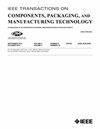少即是多:用于碳化硅功率模块的非 TIM 空气冷却陶瓷封装,扩展热性能和机械可靠性边界
IF 2.3
3区 工程技术
Q2 ENGINEERING, ELECTRICAL & ELECTRONIC
IEEE Transactions on Components, Packaging and Manufacturing Technology
Pub Date : 2024-12-09
DOI:10.1109/TCPMT.2024.3513944
引用次数: 0
摘要
本文章由计算机程序翻译,如有差异,请以英文原文为准。
Less Is More: Non-TIM Air-Cooled Ceramic Packaging for SiC Power Modules to Extend Thermal Performance and Mechanical Reliability Boundaries
Power module packaging remains one of the constraints preventing silicon carbide (SiC) devices from realizing high power density and optimal reliability in converters. This article proposes a non-thermal interface material (TIM) air-cooled power module architecture, i.e., chip-on-heatsink, to enhance both thermal performance and structural reliability. The chip-on-heatsink packaging bonds conductive copper traces and an aluminum nitride (AlN) ceramic heatsink together without requiring TIM. This non-TIM packaging design streamlines the manufacturing process by eliminating certain steps, such as attaching the bottom copper layer on substrates and assembling heatsinks, since there are few layer stacks between chips and the heatsink. Two types of 1200 V, 36 A power modules are manufactured and experimentally compared. One utilizes the non-TIM structure integrated with $50\times 38\times 24$ mm AlN ceramic heatsink, while the other follows the standard conventional packaging equipped with the same size 6063 Al Alloy heatsink. Tested under various air cooling and power loss conditions, the non-TIM power module consistently exhibits approximately a 2% reduction in junction-to-ambient thermal resistance compared to the traditional module, indicating the enhanced thermal performance of the non-TIM packaging. Furthermore, continuous performance testing confirms the suitability of the non-TIM power module packaging for operation at 650 V dc-link with 2 kW, making it a feasible choice for power converter applications. Moreover, an electro-thermal-mechanical finite element analysis (FEA) model and the digital image correlation (DIC) test are employed to evaluate the in-plane deformation. Results reveal that the maximum stress of the MOSFETs for the non-TIM packaging is significantly reduced by up to 40.2% along the defined path compared to the conventional structure, demonstrating the potential for better reliability with the proposed packaging.
求助全文
通过发布文献求助,成功后即可免费获取论文全文。
去求助
来源期刊

IEEE Transactions on Components, Packaging and Manufacturing Technology
ENGINEERING, MANUFACTURING-ENGINEERING, ELECTRICAL & ELECTRONIC
CiteScore
4.70
自引率
13.60%
发文量
203
审稿时长
3 months
期刊介绍:
IEEE Transactions on Components, Packaging, and Manufacturing Technology publishes research and application articles on modeling, design, building blocks, technical infrastructure, and analysis underpinning electronic, photonic and MEMS packaging, in addition to new developments in passive components, electrical contacts and connectors, thermal management, and device reliability; as well as the manufacture of electronics parts and assemblies, with broad coverage of design, factory modeling, assembly methods, quality, product robustness, and design-for-environment.
 求助内容:
求助内容: 应助结果提醒方式:
应助结果提醒方式:


